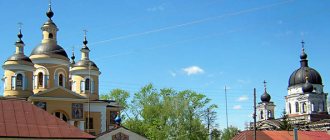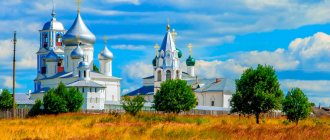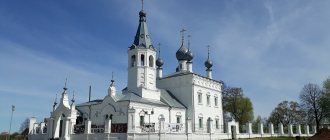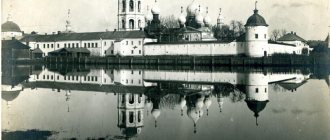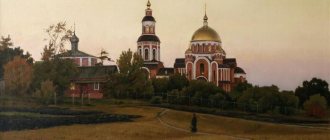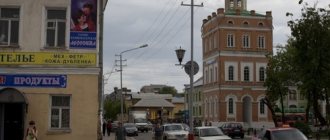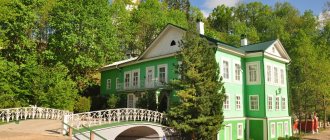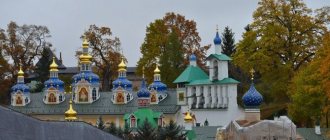The Goritsky Monastery in Pereslavl Zalessky is perhaps the most visited museum in the city - this is where the main exhibition of the Pereslavl Museum-Reserve is located. Despite the church name, there has been no monastery within these walls for 280 years. Founded at the beginning of the 14th century under Ivan Kalita, the Goritsky Assumption Monastery in Pereslavl-Zalessky was abolished in 1744. Surprisingly, of the five surviving monasteries in the city, only the Goritsky Monastery has not yet been transferred to the church - for almost 100 years it has housed a museum. Our article today will be about this unusual place (both architectural and historical).
History of the creation of the Goritsky Monastery
The exact date of construction of the monastery is unknown. This is due to a fire that destroyed his entire archive. It happened in 1722 on June 12. According to archaeologists, the Assumption Monastery was founded in 1362 (early 14th century). This is the period of the reign of Ivan Kalita.
There is an opinion that the monastery appeared much earlier (12th century). It arose on the site of the Clown Grove - a former pagan temple. The work of the Moscow Patriarch Joasaph I, “The Ladder of Power,” written by him in 1636, has been preserved. It confirms its existence.
The monastery complex got its name from the word “goritsa”. This is what the locals called any mountain. It was on the hill on the southern side of the shore of Lake Pleshcheev that the monastery was erected.
Perslavl-Zalessky (Goritsky Assumption Monastery was burned by Tatar hordes in 1382) was ravaged by the Golden Horde of Khan Tokhtamysh. All wooden buildings of the monastery were destroyed. Soon the complex was rebuilt. In gratitude for her miraculous salvation, the wife of Grand Duke Dmitry Donskoy, Evdokia, restored the monastery at her own expense in 1392.
There is a legend. Shortly before the Tatar attack, the princess arrived at the monastery. She managed to escape from her enemies along with several associates. On the raft they reached the middle of the lake. Suddenly a fog appeared, hiding them with its veil.
Since then, a unique tradition has appeared in the town of Pereslavl. Every year, Orthodox believers perform an unusual Procession of the Cross, which takes place on the sixth Sunday after Easter. They go from the Goritsky monastery to the mouth of the Trubezh River. From there they sail along the water surface in boats to the center of Lake Pleshcheevo. Thus, they pay tribute to distant historical events.
The Monk Daniel of Pereslavl took monastic orders at the Assumption Monastery, later becoming abbot here. He lived in the Goritsky monastery (from 1470 to 1500). He founded the Holy Trinity Monastery of St. Danilov (1508), which he headed. Canonized as a saint after his death.
Dmitry Prilutsky, who was an associate of St. Sergius of Radonezh, took monastic vows at the Goritsky Monastery (1371). He founded the St. Nicholas Monastery, where he became abbot. The monastery reached its peak in the 16th – 17th centuries. Evidence of this is the stone buildings, which speak of the wealth and high status of the complex.
Then the monastery owned a huge amount of land, villages where more than 5,000 peasants lived. Kings and their families visited the holy place, leaving rich gifts.
Closure and abolition
Significant changes in the life of the Goritsky complex occurred in 1744. It was closed and the Pereslavl diocese was formed (600 monasteries and 20 churches came under its control).
These are the monasteries and churches of the nearest cities:
- Alexandrov;
- Mozhaisk;
- Dmitrov;
- Volokolamsk
And the Goritsky monastery became a cathedral. The bishop's residence was located here. It was at this time that the construction of the Assumption Church was completed. Active reconstruction of the complex buildings began.
New buildings were erected:
- Bell tower;
- Church of All Saints;
- belfry;
- travel gates;
- St. Nicholas Gate Church;
- part of a stone fence with towers.
Construction took more than 40 years, but was never completed. The Goritsky Assumption Monastery was abolished in 1788. Construction work stopped. The buildings and churches were empty. Several bells were transported to St. Petersburg, and the sacristy to Moscow. However, the authorities of Prereslavl-Zaslessky decided to preserve the architectural ensemble.
The city administration began to use the buildings for various needs. The treasury, the district court, and the magistrate were located here in turn. With the beginning of the work of the city administration, the Assumption Cathedral lost its significance. Now services were held there in the summer during church holidays.
Gradually the empty premises fell into disrepair and were destroyed. However, in 1881 the diocese decided to organize a religious school on the territory of the former monastery. We built buildings and repaired the ancient Cathedral of All Saints. The educational institution operated until 1918.
After the revolution of 1917, the monastery complex became the property of the state. Later, in 1919, a local history museum was opened on its territory. It was led by the famous researcher-historian Mikhail Ivanovich Smirnov.
Later it became known as the state historical, architectural and art museum-reserve, which is still active today.
Church of the Epiphany with bell tower
The Church of the Epiphany is located on the lower floor of a four-tier bell tower, built in 1768-1777. After the abolition of the Pereslavl diocese, the bell was dismantled from here and sent to St. Petersburg to the Peter and Paul Fortress. Nowadays, the methodological department of the museum is located here, and at the very top there is an observation deck, which offers stunning views of Pereslavl-Zalessky and Lake Pleshcheyevo .
The ascent to the top is carried out first along stone and then along wooden stairs. All the ceilings between the tiers look completely new, it seems that quite recently the bell tower of the Church of the Epiphany was renovated.
On one of the levels, the windows are covered with plywood sheets, on which many tourists for some reason leave their autographs. There are many entries from 2005-2006; apparently, the bell tower was renovated about ten years ago.
From the height you have a truly magnificent view of the city. The entrance here is paid, and we did not notice a crowd of people, as is usually the case at observation platforms, but I must say that people are missing out on a lot - the views are very beautiful.
To be fair, it is worth noting that it is worth climbing the bell tower in order to see what the Goritsky Monastery looks like from above, because other views can be enjoyed from the fortress walls, and you do not need to pay for it. By the way, you can get into the bell tower only in the warm season; in winter it is closed for inspection.
Monastery architecture
The architecture of the monastery is distinguished by many small details, executed with extreme precision.
Travel gates
The travel gate is an example of Russian architecture (mid-2nd half of the 17th century). They are located in the eastern part of the complex fence.
The outer wall of the gate is framed by carved, massive arches and richly decorated with various architectural elements and sculptural figures. 2 low round columns are located on both sides of the portal below. Above each pair of pillars (in a niche) a galloping horse is sculpted.
Gatekeeper's Chamber
A small building is located to the left of the entrance to the eastern (travel) gate. In ancient documents it is called the gatekeeper's chamber.
The 2 external facades of the building are decorated very richly and magnificently, like princely or bishop's houses. The platbands have complex patterns, the walls are decorated with repeating balusters, curbs, and small semi-columns.
Refectory Chamber
Based on the western façade of the building, they determined what it looked like before. When the wall was cleared of a thick layer of old plaster, underneath it were the outlines of ancient frames that once framed the windows.
Inside the building there are unusual vaults of various shapes, as well as very interesting formwork located above the door and window openings. The refectory room located on the second floor looks impressive. In its center there is an octagonal pillar. It supports high ceilings.
Belfry
The belfry was built in the 19th century (second half). The building itself is small; it visually divides the northern fence of the monastery into two halves. Today it is used as an observation deck.
From the second tier, visitors can see the ancient city and lake.
Monastery churches and buildings
The Cathedral of the Assumption of the Blessed Virgin Mary was built between 1753 – 1861. It was designed by the architect Ivan Yakovlevich Yakovlev. The massive quadrangular structure is surrounded by covered galleries with wide arched windows. The building is crowned with 5 small domes.
Map of the Goritsky Assumption Monastery in Pereslavl-Zalessky
In the eastern part of the building, a semicircular protrusion (apse) covered with a semi-dome is attached to it. On each side rises a tower-shaped, octagonal aisle, ending with a small dome, which is equipped with light drums and dormers (lucarnes).
A large bell weighing 149 pounds 19 pounds stands in a niche in the western wall. It was cast especially for the city of Pereslavl-Zalessky at the plant of Pavel Nikolaevich Finlyandsky in 1865.
From the outside the building is quite modest. Inside, the interior of the cathedral has luxurious decoration - Baroque panels, lush stucco moldings, and picturesque frescoes. The beauty was created by the best architects of the New Jerusalem Monastery. The majestic, multi-tiered, carved iconostasis is considered an indisputable work of art. It was made by a famous master from Moscow - Yakov Zhukov.
It is covered with gilding, decorated with all kinds of figured sculptures, floral ornaments, and baroque columns. Painters from New Jerusalem painted icons. The temple is open during the warm season. The three-story Gethsemane was built next to the cathedral. It would connect him and the Church of All Saints. All that remained was to make the roof.
But the plans did not come true, the monastery was closed, construction stopped. Subsequently, the Gethsemane building was dismantled into bricks, and a theological school was built from them. Only the column, which is located in the museum, was preserved.
The tallest building of the monastery is considered to be the small Church of the Epiphany, equipped with a four-tier bell tower. Construction began in 1768 and was completed in 1777.
The small temple itself is located on the first floor. The building is covered by a towering dome with dormer windows. It is crowned with a small dome. There is a platform on the top floor of the bell tower. From there you can clearly see the entire city and Lake Pleshcheyevo.
The Church of All Saints was built in the 2nd half of the 17th century. instead of a stone building from the 16th century. Square three-apse building. The refectory chambers are adjacent to it. It is crowned with five small chapters.
Later it was rebuilt. The building was empty for more than 100 years (1780s - 1880s). Renovated in 1883. It was a house church at a religious school until 1918.
The Holy Gate is considered one of the most ancient buildings of the monastery. They appeared in the 17th century. Their lower tier with a wide arch is luxuriously decorated with figured bricks.
By the end of the same century, the Church of St. Nicholas the Pleasant was built over the gate. The square building is covered with a hipped roof. On top of it, on top of each other, there are two decreasing octahedrons crowned with a small dome. There are galleries on the sides of the temple
The entire ensemble is a harmonious combination of Moscow baroque and patterned style. The temple is operational, transferred to the Russian Orthodox Church. It contains a shrine - the shoe of St. Spyridon of Trimifuntsky.
The gift of His Holiness the Patriarch of Constantinople was brought by Mother Euphrosyne from the Greek city of Kerkyra, on the island of Corfu. There are also icons that stream myrrh. The stone fence of the monastery was completed in the 18th century. It is low, decorated with loopholes. The towers standing along the walls facing the north side are very skillfully made. The function of the fence is decorative.
In the 19th century, the Theological School buildings were added to the refectory chambers of the All Saints Church. The teachers' apartments were also located there. The building now houses an art gallery.
The pond was dug on the territory of the monastery in the 18th century. There is a reservoir nearby from which water flows through pipes. Fruit trees planted by museum employees along the banks in 1925 grow.
The one-domed chapel named after St. George the Victorious was brought from the village of Foninskoye in the 1980s. Another chapel of the same type (in honor of the Intercession), decorated with five domes, was delivered from the village of Starovo in 1983. A museum ticket office was located inside it. Both buildings are wooden and date back to the 19th century.
In 1963, the museum was given a bust of Yuri Dolgoruky, the founder of the city of Pereslavl-Zalessky. It was made by sculptor S.M. Orlov. He repeated the Moscow monument that stands on Tverskaya Square.
Holy Gate and Church of St. Nicholas the Wonderworker
The Holy Gate is considered one of the most ancient buildings of the monastery. The exact date of their construction is unknown, but scientists are inclined to assume that they appeared already in the 17th century. The Church of St. Nicholas the Wonderworker above the Holy Gate was built later, at the end of the 17th century. After the abolition of the Pereslavl diocese, no services were held in the church, but now one of the museum’s exhibitions is located there.
Opposite the passage gate through which you enter the territory of the Goritsky Monastery, you can see a small wooden chapel. She was brought to Pereslavl in 1983 from the nearby village of Starovo. Now here is the ticket office of the museum-reserve; tickets to all exhibitions are purchased here, as well as tickets to the bell tower.
It is from the bell tower that we will begin our acquaintance with the architectural monuments of the Goritsky Monastery.
Goritsky Museum-Reserve
Today the monastery is a museum complex. Its arsenal contains more than 90,000 exhibits. Many of them are unique. Entire collections of ancient icons, paintings, wooden sculptures, and silver items are collected here.
There are works by goldsmiths and goldsmiths, exhibits of the “amusing flotilla” of Peter I. Memorial halls dedicated to the artist D.N. Cordoba, opera and chamber singer F.I. Chaliapin. There are paintings by I.I. Shishkina, V.D. Polenova, I.M. Pryanishnikov, A.N. Benois, K.A. Korovin and many other painters. There is an extensive library.
Pereslavl-Zalessky (the Goritsky Assumption Monastery was transferred to the diocese of the Russian Orthodox Church by decision of the government of the Yaroslavl region in 2012) acquired another spiritual center. The museum-reserve, together with the bishop's courtyard, is working on the transfer of the complex.
Shrines[edit]
Gifter with a shoe from the relics of St. Spyridon of Trimifuntsky, brought by Mother Euphrosyne from the city of Kerkyra to the island. Corfu in Greece, presented to mother by His Holiness the Patriarch of Constantinople.
Gift box with particles of the relics of saints, martyrs and murdered infants.
Currently, several icons are streaming myrrh in the Assumption Church of the Goritsky Monastery:
— Icon of the Image of the Mother of God “Iverskaya”
— Icon of St. Luke, Confessor, Archbishop of Crimea
— The icon of the Holy Blessed Elder Matrona of Moscow, as well as the face of Christ inscribed on a once ordinary tablet and others.
Rules for visiting monasteries
Now the territory of the monastery is a museum. Services are constantly held only in St. Nicholas Church. Clothing must comply with church rules.
Women should wear long dresses and skirts (length below the knees). The upper part of the outfit has long or ¾ sleeves. A headscarf, scarf, scarf, or hat are put on the head. Men must wear shirts, T-shirts, and trousers. T-shirts and shorts are not acceptable.
Monastery opening hours
According to an agreement with the museum, the gate temple of St. Nicholas the Pleasant is open for worship: from 8.00 - 10.00 on Saturday - Sunday. All details can be clarified with Mother Euphrosyne. Phone 8(916)437 15 30,.
Museum schedule:
| Period | Opening hours |
| May – September | 10.00 – 18.00 |
| October – April | 10.00 – 17.00 |
| Day off | Monday |
| Sanitary day | Last Tuesday of the month |
Useful information for tourists
Pereslavl-Zalessky (the Goritsky Assumption Monastery does not yet operate as a religious complex) is famous for its monasteries, four of which are active. The museum hosts excursions and exhibitions. Inspection of stone buildings is available.
The temples of the museum are closed during the winter so that the cold air does not damage the interior decoration of the cathedrals. You can visit them from May to September.
It is allowed to film and photograph temples, buildings, attractions, and museum exhibitions outside and inside buildings. Flash cannot be used. If a tripod and additional lighting are used, then this is commercial photography. It is carried out with the consent of the museum administration under an agreement. Phone 3-19-10, 2-34-68.
Content
- 1 History 1.1 Founding of the monastery
- 1.2 Monastery in the 20th century
- 3.1 Church of the Resurrection
How to get to the monastery
There are regular buses from Moscow to Pereslavl-Zalessky: “Moscow – Pereslavl-Zalessky”, “Moscow – Yaroslavl”, “Moscow – Kostroma” and others. This is the only direct connection (distance – 144 km).
Departure daily from the bus station to VDNKh, from morning to evening. The duration of the trip is 2 – 3 hours. In the city (from the bus station) you can get to the monastery on foot in 20 minutes, take bus No. 1 (Museum stop) or take a taxi.
By car, the main route from the capital is along the M8 Moscow – Yaroslavl highway. From the Moscow Ring Road you need to drive 110 kilometers to the traffic police post. Behind it on the left there will be a road that leads to Pereslavl-Zalessky.
There is no train station in Pereslavl. They get there from the nearest stations in the village of Ryazantsevo (22 km) and the village. Berendeevo (20 km) via Alexandrov by bus or taxi. A more acceptable route: Moscow railway station - Sergiev Posad (train takes 1 hour 30 minutes). Then they go by bus to Pereslavl (70 km, 40 – 60 minutes).
Second Goritsky Monastery
On the banks of the beautiful Shekspa River in the village of Goritsy, Kirillovsky district, Vologda region, the Resurrection Goritsky convent is located. The monastery was founded by Efrosinya Andreevna in 1544, the widow of Prince A.I. Staritsky (the uncle of Tsar Ivan the Terrible).
Later she was forcibly sent to the monastery, giving the name Evdokia (1563). The princess was killed in 1569. Euphrosyne's body was buried on the territory of the monastery. Later he was canonized. For many years the Resurrection Monastery was a place of exile. Women from noble families lived in captivity here.
Among them:
- wife of John IV - Anna Koltovskaya;
- mother of Tsarevich Dmitry - Maria Nagaya;
- daughter of Boris Godunov - Ksenia;
- an unknown girl of the noble class (history researchers suggest that she was the failed wife of Peter II - Ekaterina Dolgorukova);
- Alexander Menshikov and his entire family were sent here.
The Church of the Resurrection was erected in 1544 instead of a wooden church. This is a two-story building. It was built with the money of Prince Staritsky. Above the temple. Nun Martha built a square bell tower in 1611.
The bell tower was thoroughly rebuilt in the 18th century. Today the church is not working, it needs to be restored. The warm Cathedral of the Holy Trinity, equipped with three altars, was built during the time of the abbess of Mauritius Khodneva in 1821. During the period of Soviet power, the House of Culture was located here. He was taken outside the monastery after the monastery was restored.
The Intercession Church on two floors was built in 1832. Funds were provided by Princess Khovanskaya (in the schema of Paraskeva). The building is warm, it is located in the eastern part of the complex.
There was a home for the disabled here during the Soviet period. Later - the administration of the state farm. The ancient building was restored. Now it has been the main temple of the complex since 2003. The territory of the monastery is enclosed by a stone wall. There is a tower at each of the four corners. Within the walls of the fence are living quarters, hotel rooms, and hospital wards.
There are three exits from the monastery in different directions of the complex. The Holy Gate goes towards the bank of the Shakspa River. The monastery has its own water supply. It appeared during the reign of the mother of Mauritius. A spring was dug outside the walls of the monastery. Pipes were laid to the stone chapel specially built for these purposes, and to all other buildings of the complex. The water supply still works today.
Inside the complex there is a stone one-story building. It is adjacent to the Church of the Resurrection. It contained a kitchen and a refectory. Several wooden buildings were also erected (late 19th – early 20th centuries). They contained living quarters and workshops.
The Church of the Presentation was built near Shekspa in the western part of the monastery. There was a cemetery next to it. The temple operated until 1937. Then a garage was located there. Restoration work began in the 1990s. Services resumed in 1999. The building was handed over to the nuns in 2000.
Outside the walls of the complex, the chapel of John the Baptist was built, a pier in 1905. Wooden buildings for household needs were also located there.
Address: index 161107, Goritsy village, Kirillovsky district, Vologda region.
Telephone: 7(81757)5-81-30.
The Goritsky Assumption Monastery of the city of Pereslavl-Zalessky and the Resurrection Monastery are monuments of architecture and the Orthodox religion of federal significance. Every year they are visited by a large number of believers, tourists, and history buffs.
Author: Tatyana B.
Article design: Mila Friedan
Mount Maura
Not far from the monastery there is another very interesting place - Mount Maura, one of the attractions of these places. Mount Maura rises picturesquely above the expanses of water and forests. From its slopes there are beautiful views of the Sheksna River and the village of Goritsy, and on the other side, when there were no tall trees here yet, Siverskoye Lake with the Kirillo-Belozersky Monastery, forests, fields and ancient villages were clearly visible. According to legend, it was from this peak that the Monk Kirill of Belozersky saw the place that was once indicated to him in a vision for the construction of a new monastery. And at the top of this mountain there is a large stone with a notch that resembles a footprint. If you believe popular rumor, then the footprint of Kirill Belozersky was miraculously imprinted on the stone, so the stone is revered as one of the shrines of these lands.
Mount Maura is located near the village of Goritsy and 6-7 km from the city of Kirillov. This is a natural monument, one of the most amazing objects of the Russian North natural park. According to its geological origin, the mountain is a huge chalk formation with three peaks ranging in height from 60 to 184 m, brought here in the distant past by the Scandinavian glacier. Covered with a dense spruce forest and flowering meadows, Mount Maura attracts with its nature, although not as wild and pristine as the Monk Kirill saw it.
An equipped ecological trail leads to the top of the mountain. On the stands set up by the national park employees, you can read information about the local flora and fauna, soils and minerals.
Bus stop where the ecological trail to Mount Maura begins
The beginning of the ecological trail to Mount Maura
The hill is covered with spruce and pine forest with a wide variety of shrubs and grasses. The beautiful meadows amaze with the abundance of rare plants. There are 10 species of orchids on the mountain alone (and in the reserve as a whole there are 23 species). Heat-loving orchids have perfectly adapted to the Vologda climate, which is so different from the tropics familiar to these plants. In general, the mountain is an interesting natural phenomenon, since the vegetation of its southern slope is characteristic of the meadows and fields of central Russia, and the northern slope is characteristic of the forests of the tundra taiga, that is, the north of the Arkhangelsk region and Karelia.
